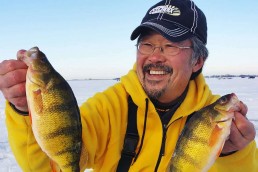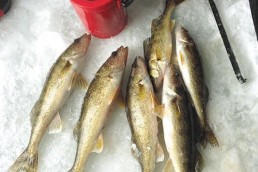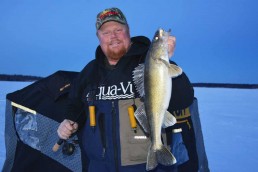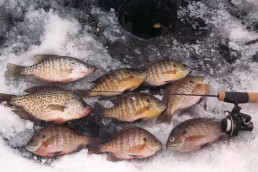First Ice, Early Ice Best for Action
SHARE THIS POST
The best odds for catching fish are often at first ice. The water below the hard surface then still holds a good supply of oxygen and fish are actively feeding. But safety is a must. First ice is when anglers should travel by foot because the ice is too thin for heavier traffic. But you will often witness some of the hottest action of winter. Many top ice fishing anglers in North America are champing at the bit to be on the ice as soon as possible, just remember to wear an inflatable lifejacket and always go fishing with a buddy.
Try targeting the weed edges nearest to shore, as that’s where you’ll find crappies, sunfish, walleyes and perch during the day. Crappies and walleyes start roaming farther from the weed edges after dark and both species are comfortable feeding at dusk and at low-light conditions.
When walking on ice, travel light. A 5-gallon bucket can hold your electronics, your rods spooled with a 4-pound-test monofilament line and most of the tackle you need. And if you desire some protection from the elements, load everything into a portable one-man fish house. Mobility is often the secret to ice-fishing success.
“The key to being successful on the ice is to be mobile and going to the fish,” said Perry Good, Hall of Fame angler. “As soon as they leave a spot, you have to relocate them. During open water, you don’t just anchor somewhere all day. It’s the same in winter; you’re always looking for active fish.”
A small tackle box is enough to hold the necessities. We’ve just found some awesome, new lures from Venom Tackle. Their Tungsten Core Minnows and jigs are going to catch a ton of fish. Tungsten jigs are heavier, but small and the Core Minnows have a strong glow outer shell for attracting fish.
Always carry along small minnows, waxworms, and euro larvae, also known simply as spikes. Perry Good and many other top anglers always have all three along because fish can change their preference. The bigger crappies, slab-sized ones that stretch to 14 inches, prefer minnows, but they will also bite on the waxworms or spikes. Walleyes and perch will sometimes bite on the insects, but they also like a minnow on a spoon or jig. Walleyes will also bite on a fathead minnow or a shiner on a plain hook held suspended by a float bait.
Remember to also bring along a selection of soft plastics on glow-in-the-dark jig heads, as this color works great when the water is dingy or stained, or after dark or when fish just want something different.
Good also believes that darkness and low-light times just after sunrise or before sunset are even more critical on the ice than during the summer for walleyes and crappies. Perch and bluegills bite all day, but forget about catching them after the sun goes down.
The key locations for crappies and sunfish are the same during the magic first-ice period.
“Wherever the fish were in late fall, that’s where they’ll be now. That’s usually just off the weedlines, even if the weeds are dying,” Good said.
Observation has taught him that stocked, hatchery-raised walleyes reared in weedy ponds always seek out weed edges in stocked lakes. As a result, you’ll catch them in the same spots you’ll find the crappies. But naturally spawned walleyes are found more on hard-bottom rock or gravel bars with deep water nearby. They’re usually close to where you’ll find perch—this species likes the mud and holds insects they eat. They’ll also be found on transition areas where the bottom changes from gravel to sand to mud. But some perch will be in the weeds, too.
Are you enjoying this post?
You can be among the first to get the latest info on where to go, what to use and how to use it!
Since weeds are high-percentage spots, you should drill several holes at various places along a weedline as soon as ice reaches 4 inches, the minimum thickness strong enough to support an angler. It helps if you have scouted the area in a boat during open water and entered waypoints to mark the points or inside turns on a weed edge with your GPS.
We’ll typically use two rods and drill two holes: one hole for a deadstick with a Venom float combined with a smaller hook tipped with a minnow. For crappies, start with the bait a couple of feet off the bottom. For walleyes, set your lure a few inches off the bottom. Then, put your transducer from your electronics in the other where you will actively jig. Watch your electronics for signs of fish. Crappies are often those marks suspended well off the bottom. Raise your lure just above them.
“They’ll think the bait is escaping, and they’ll slam it,” Good said. “Walleyes, too. You can play with them and pull it away to entice a strike. Your electronics turn ice fishing into a video game—I can’t imagine all those years we fished without them.”
He says to try different jigging actions and don’t over work the jig.
“It’s amazing. The one you are working will often outfish the float rig.”
Good adds the key element to having a deadstick is to bring in the fish with your jigging motion and any inactive fish will bite the float.
Switch from one kind of live bait to another and change up your jig colors to find out what the fish want. If you know fish are below you but you can’t get them to bite no matter what, an underwater camera is a good tool. You might want to lower the lens and discover the marks you saw were only “junk” fish.
Keep moving, especially when the action stops or you aren’t marking fish. Stay along the weedline during the day, but when fish quit biting after the sun goes down move away from the weed edge and go toward the deeper water. That’s where you’ll find crappies and walleyes.
“Those fish will bite best as the sun goes down,” Good said.
Again, remember this is a time when extreme caution is needed. Ice may be thinner in places, especially with current or areas fed by underwater springs still prevalent. And never go ice fishing alone and always tell someone where you are going and what time to expect you home. A rope tied to a floatation cushion is also good to have along, and handheld ice spikes are also a must to keep handy. Being safe and prepared will ensure you have fun ice fishing during the early season.
MWO
SHARE THIS POST
Did you enjoy this post?
You can be among the first to get the latest info on where to go, what to use and how to use it!
Ted Takasaki
Ted Takasaki is an International Fishing Hall of Fame professional angler who has been featured in many national outdoor magazines and television shows. Takasaki has appeared in front of thousands of angling enthusiasts and is considered one of America’s top walleye and multispecies anglers. Follow him on his Facebook page.



